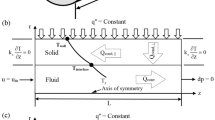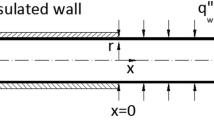Abstract
Heat transfer in laminar flow microtube is numerically explored with an objective of discriminating conjugate heat transfer process experienced in a microtube under two different thermal conditions. Two classical thermal conditions – constant heat flux and constant wall temperature – are imposed separately on the outer surface of a microtube. Wide parametric variations are considered in this study, for the two thermal conditions, albeit the problem under consideration being very classical from both geometry and thermal condition point of view. The parametric variations considered in this work include wall thickness, wall conductivity and coolant flow rate. An expression for Nusselt number in terms of radial (or transverse) and axial conduction number is presented and validated against existing theoretical correlation as well as reported experimental data for both circular and non-circular channels. Dominance of axial conduction over radial (or transverse) conduction is explored and it is found that the effect of wall material on conjugate heat transfer plays an important role. Additionally, it is also observed that with the increase in coolant flow rate, the ratio of radial to axial conduction number increases for both thermal boundary conditions.















Similar content being viewed by others
Abbreviations
- A cf :
-
cross-sectional area of fluid domain, m2
- A cs :
-
cross-sectional area of solid wall, m2
- A surf :
-
surface area of solid–fluid interface, m2
- c p :
-
specific heat of fluid, J/kgK
- D :
-
inner diameter of microtube, m
- h z :
-
local heat transfer coefficient, W/m2K
- k s :
-
solid thermal conductivity, W/mK
- k f :
-
fluid thermal conductivity, W/mK
- k sf :
-
ratio of ks to kf
- L :
-
total length of tube, m
- M :
-
conduction number in axial direction
- Nu z :
-
local Nusselt number
- Nu avg :
-
average Nusselt number
- P :
-
parameter for axial conduction
- Pr :
-
Prandtl number
- q′′:
-
constant wall heat flux, W/m2
- \( {\text{q}}^{\prime\prime}_{\text{i}} \) :
-
heat flux experienced at the solid–fluid interface of the microtube, W/m2
- \( {\text{q}}^{\prime\prime}_{\text{s}} \) :
-
heat flux applied on the outer surface of the microtube, W/m2
- Q cond,|| :
-
conduction heat transfer in axial direction, W
- Q cond,⊥ :
-
conduction heat transfer in radial/transverse direction, W
- Q conv :
-
convective heat transfer, W
- q w :
-
wall heat flux, W/m2
- R :
-
conduction number in radial/transverse direction (–)
- Re :
-
Reynolds number
- R cond,|| :
-
conduction thermal resistance in axial direction, K/W
- R cond,⊥ :
-
conduction thermal resistance in radial/transverse direction, K/W
- R conv :
-
convective thermal resistance, K/W
- R total :
-
total thermal resistance, K/W
- r i :
-
inner radius of microtube, m
- r o :
-
outer radius of microtube, m
- T :
-
constant wall temperature, K
- \({\bar{T}}_a\) :
-
average temperature of the surface when the thermal condition is imposed, K
- \({\bar{T}}_f\) :
-
average temperature of the bulk, K
- T b :
-
bulk temperature, K
- \({\bar{T}}_i\) :
-
average temperature of the solid–fluid interface, K
- T w :
-
wall temperature, K
- T w, in :
-
wall temperature at the inlet cross-section, K
- T w, out :
-
wall temperature at the outlet cross-section, K
- U :
-
fluid velocity in the axial direction, m/s
- Ū :
-
average fluid velocity at inlet, m/s
- Z :
-
axial coordinate, m
- z * :
-
non-dimensional axial coordinate
- δ f :
-
inner radius of the tube, m
- δ s :
-
thickness of the tube wall (ro–ri), m
- δ sf :
-
ratio of δs to δf
- Φ :
-
non-dimensional local heat flux
- Θ :
-
non-dimensional temperature
- f :
-
fluid
- i :
-
inner surface of tube
- o :
-
outer surface of tube
- s :
-
solid
- w :
-
tube outer surface/wall
References
Khandekar S and Moharana M K 2014 Some applications of micromachining in thermal-fluid engineering. In: Jain V K (Ed.) Introduction to Micromachining, 2nd ed. New Delhi: Narosa Publishing House
Maranzana G, Perry I and Maillet D 2004 Mini- and micro-channels: influence of axial conduction in the walls. Int. J. Heat Mass Transf. 47(17–18): 3993–4004
Li Z, He Y L, Tang G H and Tao W Q 2007 Experimental and numerical studies of liquid flow and heat transfer in microtubes. Int. J. Heat Mass Transf. 50(17–18): 3447–3460
Rahimi M and Mehryar R 2012 Numerical study of axial heat conduction effects on the local Nusselt number at the entrance and ending regions of a circular microchannel. Int. J. Therm. Sci. 59: 87–94
Stephan K and Preußer P 1979 Wärmeübergang und maximale Wärmestromdichte beim Behältersieden binärer und ternärer Flüssigkeitsgemische. Chem. Ing. Tech. 51(1): 37
Peng X F and Peterson G P 1996 Convective heat transfer and flow friction for water flow in microchannel structures. Int. J. Heat Mass Transf. 39(12): 2599–2608
Choi S B, Barron R F and Warrington R Q 1991 Fluid flow and heat transfer in micro-tubes. In: Choi D et al (Eds.) Micro-Mechanical Sensors, Actuators and Systems, Proceedings of ASME DSC 32: 121–128
Liu Z G, Liang S Q and Takei M 2007 Experimental study on forced convective heat transfer characteristics in quartz microtube. Int. J. Therm. Sci. 46(2): 139–148
Lin T Y and Kandlikar S G 2012 A theoretical model for axial heat conduction effects during single-phase flow in microchannels. J. Heat Transf. 134(2): 020902
Moharana M K, Singh P K and Khandekar S 2012 Optimum Nusselt number for simultaneously developing internal flow under conjugate conditions in a square microchannel. J. Heat Transf. 134(7): 071703
Duryodhan V S, Singh S G and Agrawal A 2017 Heat rate distribution in converging and diverging microchannel in presence of conjugate effect. Int. J. Heat Mass Transf. 104: 1022–1033
Sahar A M, Wissink J, Mahmoud M M, Karayiannis T G and Ishak M S A 2017 Effect of hydraulic diameter and aspect ratio on single phase flow and heat transfer in a rectangular microchannel. Appl. Therm. Eng. 115: 793–814
Moharana M K and Khandekar S 2013 Effect of aspect ratio of rectangular microchannels on the axial back conduction in its solid substrate. Int. J. Microscale Nanoscale Therm. Fluid Transport Phenom. 4(3–4): 211–229
Şen S and Darici S 2017 Transient conjugate heat transfer in a circular microchannel involving rarefaction, viscous dissipation and axial conduction effects. Appl. Therm. Eng. 111: 855–862
Zhai L, Xu G, Quan Y, Song G, Dong B and Wu H 2017 Numerical analysis of the axial heat conduction with variable fluid properties in a forced laminar flow tube. Int. J. Heat Mass Transf. 114: 238–251
Tiwari N and Moharana M K 2019 Numerical study of thermal enhancement in modified raccoon microchannels. Heat. Transf. Res. 50(6): 519–543
Ghani I A, Kamaruzaman N and Sidik N A C 2017 Heat transfer augmentation in a microchannel heat sink with sinusoidal cavities and rectangular ribs. Int. J. Heat Mass Transf. 108: 1969–1981
Sidik N A C, Muhamad M N A W, Japar W M A A and Rasid Z A 2017 An overview of passive techniques for heat transfer augmentation in microchannel heat sink. Int. Commun. Heat Mass Transf. 88: 74–83
Li P, Luo Y, Zhang D and Xie Y 2018 Flow and heat transfer characteristics and optimization study on the water-cooled microchannel heat sinks with dimple and pin-fin. Int. J. Heat Mass Transf. 119: 152–162
Avcı M, Aydın O and Arıcı M E 2012 Conjugate heat transfer with viscous dissipation in a microtube. Int. J. Heat Mass Transf. 55(19–20): 5302–5308
Celata G P, Cumo M, Marconi V, McPhail S J and Zummo G 2006 Microtube liquid single-phase heat transfer in laminar flow. Int. J. Heat Mass Transf. 49(19–20): 3538–3546
Koo J and Kleinstreuer C 2004 Viscous dissipation effects in microtubes and microchannels. Int. J. Heat Mass Transf. 47: 3159–3169
Lelea D, Nishio S and Takano K 2004 The experimental research on microtube heat transfer and fluid flow of distilled water. Int. J. Heat Mass Transf. 47(12–13): 2817–2830
Zhang S X, He Y L, Lauriat G and Tao W Q 2010 Numerical studies of simultaneously developing laminar flow and heat transfer in microtubes with thick wall and constant outside wall temperature. Int. J. Heat Mass Transf. 53(19–20): 3977–3989
Darıcı S, Bilir Ş and Ateş A 2015 Transient conjugated heat transfer for simultaneously developing laminar flow in thick walled pipes and minipipes. Int. J. Heat Mass Transf. 84: 1040–1048
Ateş A, Darıcı S and Bilir Ş 2010 Unsteady conjugated heat transfer in thick walled pipes involving two-dimensional wall and axial fluid conduction with uniform heat flux boundary condition. Int. J. Heat Mass Transf. 53(23–24): 5058–5064
Chai L, Xia G, Wang L, Zhou M and Cui Z 2013 Heat transfer enhancement in microchannel heat sinks with periodic expansion–constriction cross-sections. Int. J. Heat Mass Transf. 62: 741–751
Holman J P 1972 Heat transfer, 10th ed. New York: McGraw-Hill
Tso C P and Mahulikar S P 2000 Experimental verification of the role of Brinkman number in microchannels using local parameters. Int. J. Heat Mass Transf. 43(10): 1837–1849
Sui Y, Lee P S and Teo C J 2011 An experimental study of flow friction and heat transfer in wavy microchannels with rectangular cross section. Int. J. Therm. Sci. 50: 2473–2482
Xu B, Ooi K T, Mavriplis C and Zaghloul M E 2003 Evaluation of viscous dissipation in liquid flow in microchannels. J. Micromech. Microeng. 13(1): 53–57
Morini G L and Spiga M 2007 The role of the viscous dissipation in heated microchannels. J. Heat Transf. 129(3): 308–318
Lee P S and Garimella S V 2006 Thermally developing flow and heat transfer in rectangular microchannels of different aspect ratios. Int. J. Heat Mass Transf. 49(17–18): 3060–3067
Perkins K R, Schade K W and McEligot D M 1973 Heated laminarizing gas flow in a square duct. Int. J. Heat Mass Transf. 16(5): 897–916
Bergman T L, Lavine A S, Incropera F P and DeWitt D P 2011 Fundamentals of heat and mass transfer, 7th ed. New York: John Wiley and Sons
Author information
Authors and Affiliations
Corresponding author
Rights and permissions
About this article
Cite this article
Tiwari, N., Moharana, M.K. Parametric analysis of axial wall conduction in a microtube subjected to two classical thermal boundary conditions. Sādhanā 44, 170 (2019). https://doi.org/10.1007/s12046-019-1151-8
Received:
Revised:
Accepted:
Published:
DOI: https://doi.org/10.1007/s12046-019-1151-8




